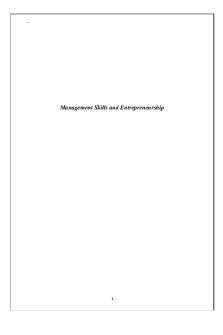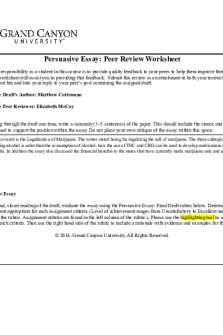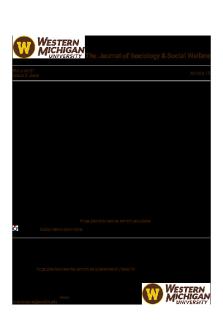Cowspiracy reviewed PDF
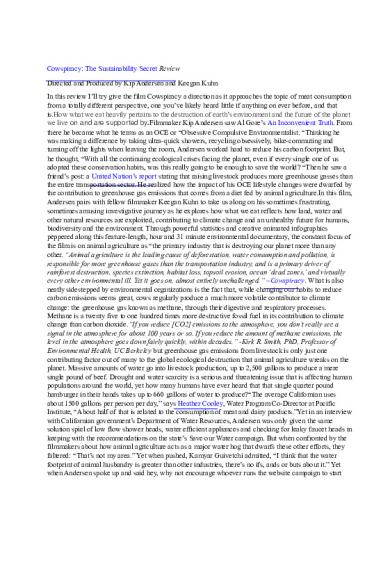
| Title | Cowspiracy reviewed |
|---|---|
| Course | Food Nutrition And Dietetics |
| Institution | Egerton University |
| Pages | 3 |
| File Size | 113.8 KB |
| File Type | |
| Total Downloads | 37 |
| Total Views | 136 |
Summary
this is an essayed review of the netflix documentary entitled Cowspiracy: The Sustainability Secret a 2014 documentary film that explores the impact of animal agriculture on the environment and investigates the policies of environmental organizations on this issue....
Description
Cowspiracy: The Sustainability Secret Review Directed and Produced by Kip Andersen and Keegan Kuhn In this review I’ll try give the film Cowspiracy a direction as it approaches the topic of meat consumption from a totally different perspective, one you’ve likely heard little if anything on ever before, and that is.How what we eat heavily pertains to the destruction of earth’s environment and the future of the planet we live onandar es uppor t edby .Filmmaker Kip Andersen saw Al Gore’s An Inconvenient Truth. From there he became what he terms as an OCE or “Obsessive Compulsive Environmentalist. “Thinking he was making a difference by taking ultra-quick showers, recycling obsessively, bike-commuting and turning off the lights when leaving the room, Andersen worked hard to reduce his carbon footprint. But, he thought, “With all the continuing ecological crises facing the planet, even if every single one of us adopted these conservation habits, was this really going to be enough to save the world? “Then he saw a friend’s post: a United Nation’s report stating that raising livestock produces more greenhouse gasses than the entire transportation sector. He realized how the impact of his OCE lifestyle changes were dwarfed by the contribution to greenhouse gas emissions that comes from a diet fed by animal agriculture.In this film, Andersen pairs with fellow filmmaker Keegan Kuhn to take us along on his sometimes frustrating, sometimes amusing investigative journey as he explores how what we eat reflects how land, water and other natural resources are exploited, contributing to climate change and an unhealthy future for humans, biodiversity and the environment. Through powerful statistics and creative animated infographics peppered along this feature-length, hour and 31 minute environmental documentary, the constant focus of the film is on animal agriculture as “the primary industry that is destroying our planet more than any other. “Animal agriculture is the leading cause of deforestation, water consumption and pollution, is responsible for more greenhouse gases than the transportation industry, and is a primary driver of rainforest destruction, species extinction, habitat loss, topsoil erosion, ocean ‘dead zones,’ and virtually every other environmental ill. Yet it goes on, almost entirely unchallenged.” –Cowspiracy. What is also neatly sidestepped by environmental organizations is the fact that, while changing our habits to reduce carbon emissions seems great, cows regularly produce a much more volatile contributor to climate change: the greenhouse gas known as methane, through their digestive and respiratory processes. Methane is a twenty five to one hundred times more destructive fossil fuel in its contribution to climate change than carbon dioxide.“If you reduce [CO2] emissions to the atmosphere, you don’t really see a signal in the atmosphere for about 100 years or so. If you reduce the amount of methane emissions, the level in the atmosphere goes down fairly quickly, within decades.” -Kirk R. Smith, PhD, Professor of Environmental Health, UC Berkeley but greenhouse gas emissions from livestock is only just one contributing factor out of many to the global ecological destruction that animal agriculture wreaks on the planet. Massive amounts of water go into livestock production, up to 2,500 gallons to produce a mere single pound of beef. Drought and water scarcity is a serious and threatening issue that is affecting human populations around the world, yet how many humans have ever heard that that single quarter pound hamburger in their hands takes up to 660 gallons of water to produce?“The average Californian uses about 1500 gallons per person per day,” says Heather Cooley, Water Program Co-Director at Pacific Institute, “About half of that is related to the consumption of meat and dairy products.”Yet in an interview with Californian government’s Department of Water Resources, Andersen was only given the same solution spiel of low flow shower heads, water efficient appliances and checking for leaky faucet heads in keeping with the recommendations on the state’s Save our Water campaign. But when confronted by the filmmakers about how animal agriculture acts as a major water hog that dwarfs these other efforts, they faltered: “That’s not my area.” Yet when pushed, Kamyar Guivetchi admitted, “I think that the water footprint of animal husbandry is greater than other industries, there’s no ifs, ands or buts about it.” Yet when Andersen spoke up and said hey, why not encourage whoever runs the website campaign to start
encouraging people to eat less meat now that these studies are coming out. “I don’t think that’ll happen.” Why? “Because of the way government is set up. “As Andersen contacts one environmental organization after another, hoping to tackle the issue of why animal agriculture is such a taboo issue in the environmental sect, he is repeatedly given evasive answers to questions and denied interviews. Meanwhile, we are continually thrown statistics with accompanying animation to help depict the kinds of devastation animal agriculture wreaks on our environment, from livestock excrement amounting to 116 thousand pounds produced every second in the US alone to the hundreds of nitrogen flooded dead zones, areas devoid of life. “Any meaningful discussion about our oceans has to always begin by frank discussions about land-based animal agriculture,” says Oppenlander, “which is not what is at the apex of our conservation group’s discussions, “Our filmmakers quickly realize how these groups dedicated solely to saving the environment avoid any mention of animal agriculture and certainly don’t promote a more plant-based diet because, being that they are membership organizations that rely heavily on financial donors, they don’t want to alienate their members by telling them to change their lifestyle in a much more significant, highly personal way than the obligatory switching off the lights when you leave the room. “If they get identified as being anti-meat or challenging people on their everyday habits, something that’s so dear to people, it will hurt with their fundraising.” Michael Pollan, environmental author, says of environmental organizations that avoid the topic of animal agriculture. These organizations are, in the end, businesses and, without a reliable source of funding, they’re not going to be able to continue to operate. Yet many of these organizations are supposedly dedicated to protecting rainforests and oceans, yet don’t admit how livestock production and grazing impacts the very places they’re trying to save. The Amazon rainforest, the lungs of our planet, is a prime example. Throughout the film, we continue to feel like we’re pulling teeth with organizations about admitting the livestock industry and our very diet has anything to do with their environmental initiatives. And Andersen felt like he was walking in circles in a Cowspiracy twilight zone trying to get even rainforest protection-specific agencies to give the most obvious answer to what the main cause of deforestation is.But then Amazon Watch’s Program Director Leila Salazar Lopez laid it out. What was happening to the people who were standing up in opposition to special interest groups like the cattle industry and agribusiness? People were putting themselves out there in Brazil, saying that cattle ranching was specifically responsible for destroying the Amazon and they were being silenced. “A lot of the people who were speaking up got killed,” says Salazar Lopez. “A lot of people keep their mouths shut because they don’t want to be the next one with a bullet to their head. “Essentially, what conducts this neat sweeping under the rug of such a major issue is something deeper and more all-encompassing: The legislative power of the U.S. livestock industry and how heavily meat-eating is incorporated into our lifestyles. The livestock industry is protected by massive amounts of money and lobbying power. “Once they become so large and wealthy,” says Wenonah Halter, Executive Director of Food & Water Watch, “then they can dictate the federal policies around producing food, because they have so much political power. “In the last third of the film, we hear a recorded voicemail message, its Andersen and Kuhn’s film backer apologizing for having to pull funding and support for the very film we’re watching, due to its controversial theme. Career cattle farmer Howard Lyman was sued by cattle industry for speaking the truth against animal agriculture on the Oprah Winfrey show. “If you cause a disruption in the profits of the animal industry, you’re guilty under the Patriot Act.” When Andersen asks if he should be concerned about making a documentary like this one? Lyman laughs and says, “Of course! If you don’t realize right now that you’re putting your neck on the chopping block, you better take that camera and throw it away. “With his funding being dropped and learning that American journalists and activists speaking out against animal agriculture and factory farms were being targeted as terrorists by the FBI, Andersen considered doing just that, throwing it away. But then, he realized “this issue was way bigger than any personal concern I could have for myself, this was about all life on earth hanging in the balance of our actions.” The Cowspiracy crew was not giving up.
Overall, the film covers an enormous topic that involves a great deal of heavy information thrown at you for ninety minutes straight. But I think that we need to better understand not just where our food is coming from, but the impact it has on our earth, our environment, wildlife, our grandchildren, and our future. I don’t think you need to come away from this film thinking you are awful if you consume meat or dairy, but rather thinking about it at all and how it connects to environmental degradation, climate change and a healthy future for all life. Earth cannot support our meat and dairy habit that is the takeaway message here. But by even taking the smallest steps to reducing your consumption of animal products can help move us toward a more sustainable future. Consider it!...
Similar Free PDFs

Cowspiracy reviewed
- 3 Pages

Cowspiracy documentary
- 3 Pages
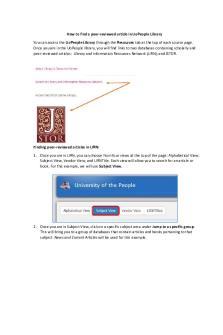
Finding peer-reviewed articles
- 4 Pages

Noah Essay Reviewed - Grade: A
- 3 Pages
Popular Institutions
- Tinajero National High School - Annex
- Politeknik Caltex Riau
- Yokohama City University
- SGT University
- University of Al-Qadisiyah
- Divine Word College of Vigan
- Techniek College Rotterdam
- Universidade de Santiago
- Universiti Teknologi MARA Cawangan Johor Kampus Pasir Gudang
- Poltekkes Kemenkes Yogyakarta
- Baguio City National High School
- Colegio san marcos
- preparatoria uno
- Centro de Bachillerato Tecnológico Industrial y de Servicios No. 107
- Dalian Maritime University
- Quang Trung Secondary School
- Colegio Tecnológico en Informática
- Corporación Regional de Educación Superior
- Grupo CEDVA
- Dar Al Uloom University
- Centro de Estudios Preuniversitarios de la Universidad Nacional de Ingeniería
- 上智大学
- Aakash International School, Nuna Majara
- San Felipe Neri Catholic School
- Kang Chiao International School - New Taipei City
- Misamis Occidental National High School
- Institución Educativa Escuela Normal Juan Ladrilleros
- Kolehiyo ng Pantukan
- Batanes State College
- Instituto Continental
- Sekolah Menengah Kejuruan Kesehatan Kaltara (Tarakan)
- Colegio de La Inmaculada Concepcion - Cebu





